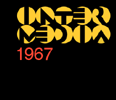public record
<-- previous | next -->
Vancouver Sun
Sun. May 31, 1968
Intermedia Nights - An Analysis: It's fun but doesn't too much produce a media-message glut?
By ANN ROSENBERG
Intermedia Nights brought to the spectator-participant an admixture of the highly professional and amateur, sometimes working on the same project.
In the sense that one had had to get involved with one's body, senses and even one's temper, the five day festival was cool, man, cool.
The simultaneity of complimenting media within events presented in a public space an artistic extension of some of the simplest concepts put forth in Marshall McLuhan's book Understanding Media.
And after days of viewing it, one could begin to examine the merits and short comings of an art festival based in part upon this McLuhan statement:
"Is it not evident that the moment sequence yields to the simultaneous, one is in the world of structure and of configuration. Is that not what has happened in physics, painting and poetry and in communication. Specialized segments of attraction have shifted to total field and we may now say "the medium is the message" quite naturally. before electric speed and total field, it was not obvious that the medium is the message. The message it seemed was the 'content.' People used to ask what a painting was ABOUT.
A craftsmanly and certainly a complex work was Audry Capel Doray's environment with intricate technical programming actualized by Cybernetics Incorporated.
A spinning disc covered with symbols of experience culled from contemporary magazines and books about art, revolved at the whim of the spectator until it set in motion an elaborate sound tract and illumination patterns that were sensitively related to each other in terms of light intensity and pitch of sound. The wheel came to rest now and then on visual symbols equipped with headings such as SEX, LOVE, SHOCK. For added effect the participant could rub hands around the rim of the hoop encircling the light-box drum to set into motion flashing patterns of lights centered within the wheel of fortune.
And most exciting of all, at certain moments the speed of the wheel's motion and the pushing of the lights obliterated the images in a grey started blur. So many association-triggering representations so many changes of light and sound occurred simultaneously that one was left appreciating only the essential qualities of light, sound and visual pattern - all that content, scrupulously included within the wheel ceased to be central, in fact eventually vanished. The media triumphed.
Similar in its complexity was a Plexiglas torso decorated with Botticelli's ethereal Venus, poetic platitudes and news media 'visuals' that throbbed dark and bright under instant pulse of light within and lights decorating the frame of the work. A sound tract changed as quickly as the lights flashed, sometimes beating in resonance, at other times, running counter to the rhythm of the illumination. Again so much greeted the senses, that the spectator could concentrate upon no single facet, but was left with some instructive understanding about the nature of total presentation.
A third work (another plexiglas torso) was also equipped with sound. and showed a group of generalized figures engaged in friendly attitudes, backlit by polarized light familiarly used in juke boxes and pinball machines.
In Audrey Doray's work, since there are so many fragmented parts working together or in conflict that the totality can only be understood instantaneously and fleetingly as each multi-facited sound-augmented image flashes before the mind. The multiplicity of the viewer the "conceit' of sorting out a content message, traditionally associated with the proper spectators roll in confrontation with a work of art. The medium is the message.
A second artist, John Masciuch, contributed an outstanding medium to Intermedia Nights, the neon tube that could be enlivened by the touch of the hand. his presentation in the small Emily Carr room of a neon-tube that glowed under the pats and caresses of the viewer, was quite beautiful as far as it went. But more in the Intermedia Spirit was the way in which he allowed other people to use the light-bars he provided to create settings for various dance and sound/light performances.
But one thing strikes me as unfortunate about the whole McLuhan-orientation in these art works and in the Intermedia Nights Performances. Perhaps the art works come of best because they are designed as transportable vehicles for the expression of structure, light and sound. But it is curious to consider that without the structure of Prisma and the Wheel of Fortune the message one receives from the confrontation of complex media is virtually identical, and very general. And so where concrete structural material is absent, the amalgam of umpteen sensory-stimulating devices induce in the spectator reactions so basic they are rather trite.
What I am trying to say is that a constant diet of Intermedia events and art works, however brilliant and enjoyable they may be singly, produces in the spectator/participant a media message glut. Then the most stimulating separateness of each Intermedia experience leaves in the mind and soul of the viewer the vaguest and most general opinion that music, light, and structure groove, just groove. That's all! That's why, I think, content, even of the most hideous old-fashioned kind can never be entirely replaced by so-called instant total awareness.
public record
<-- previous | next -->
